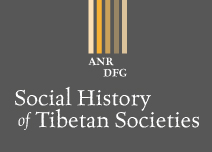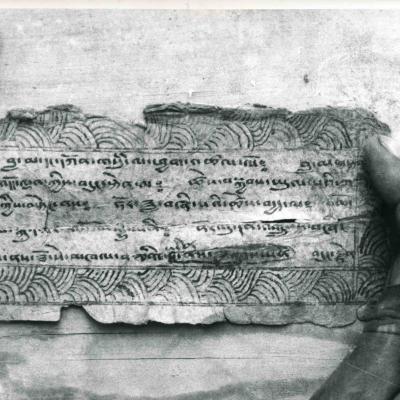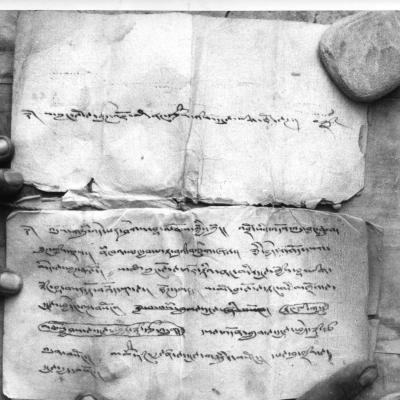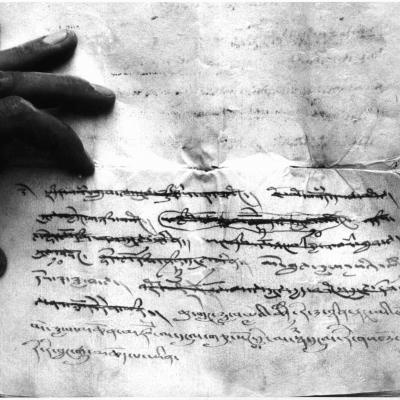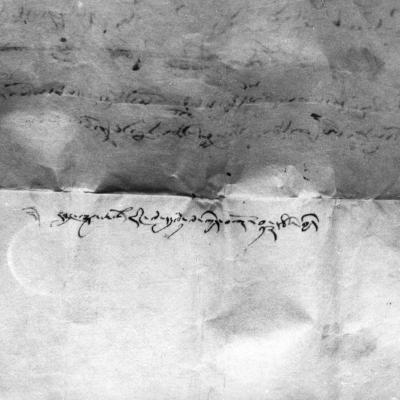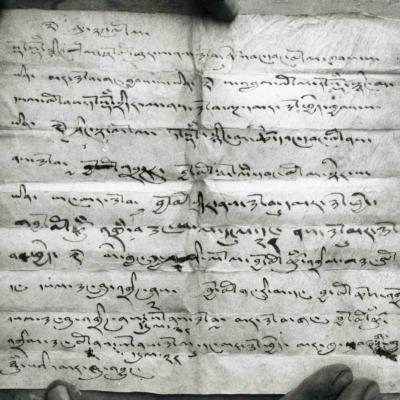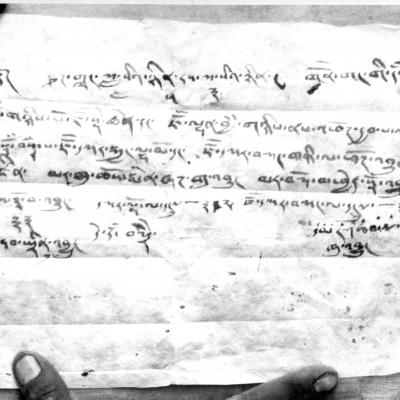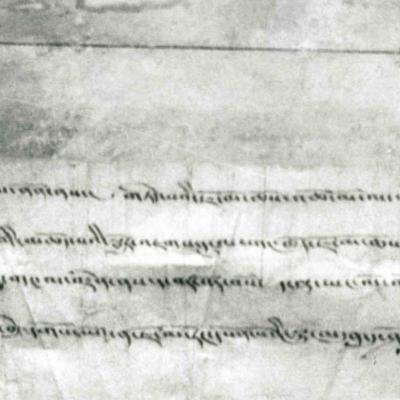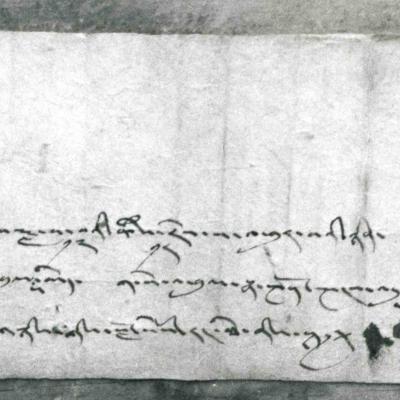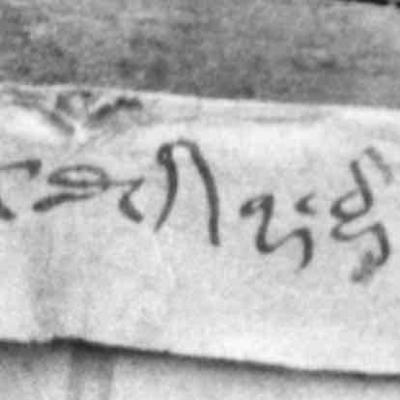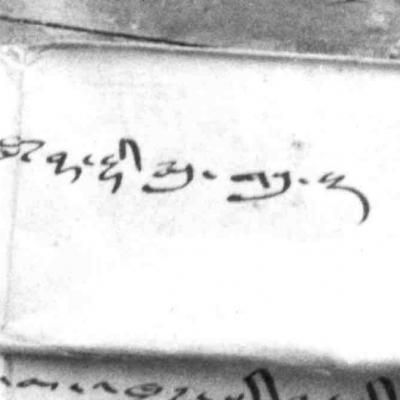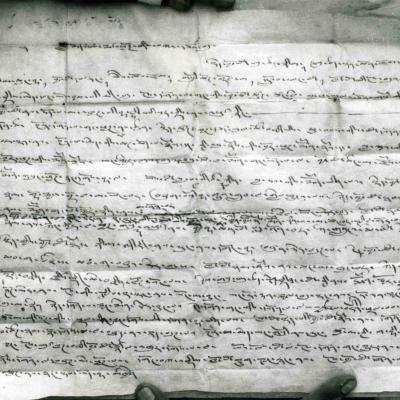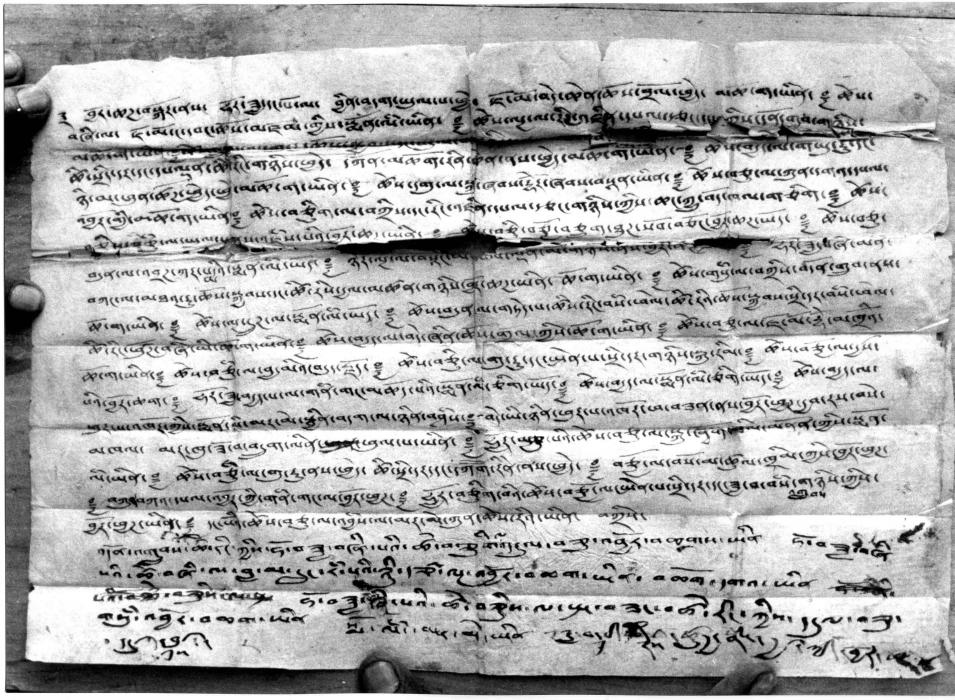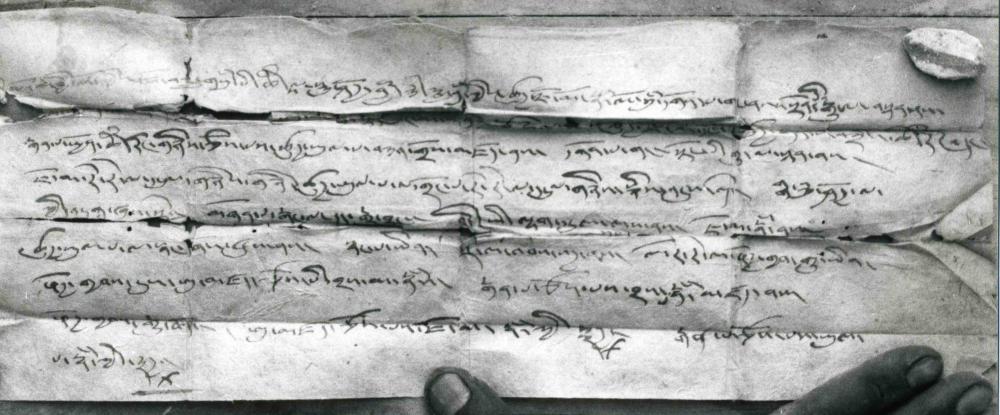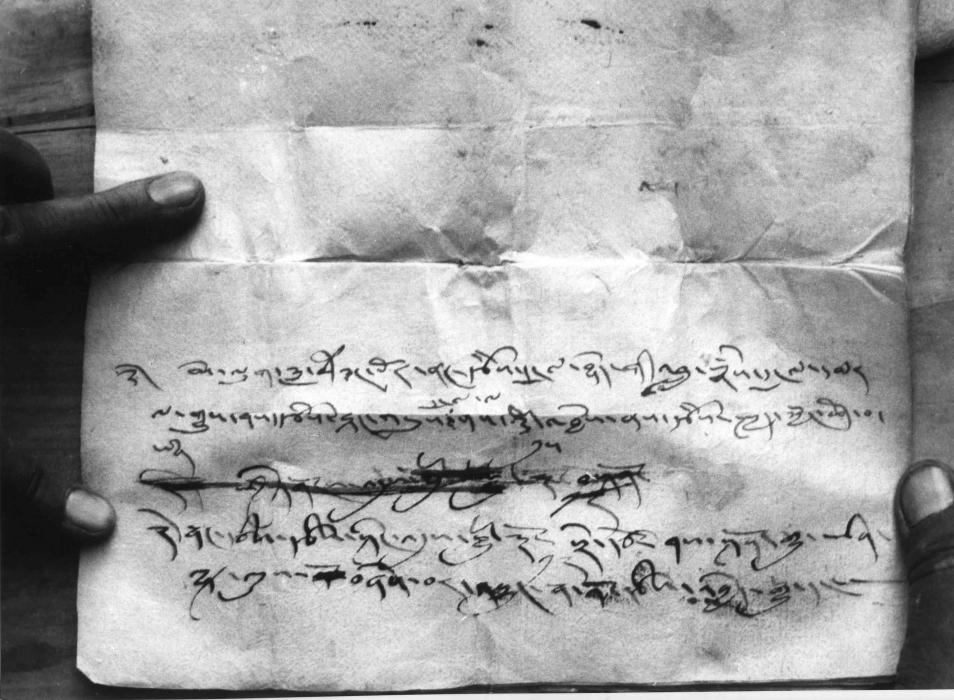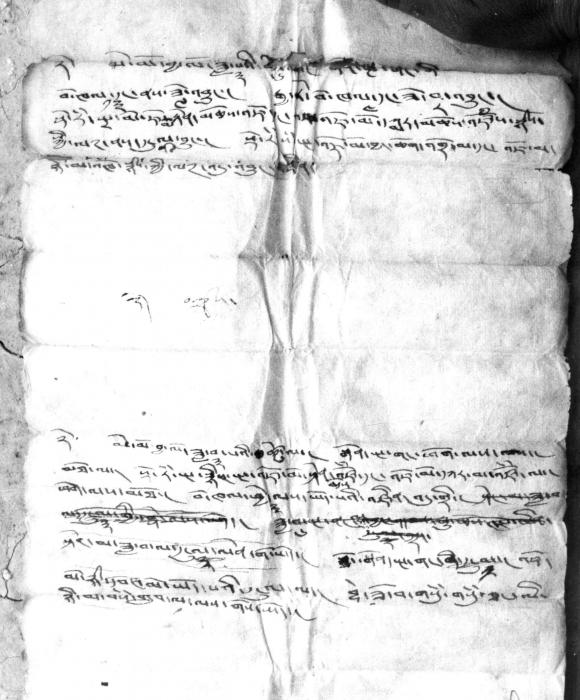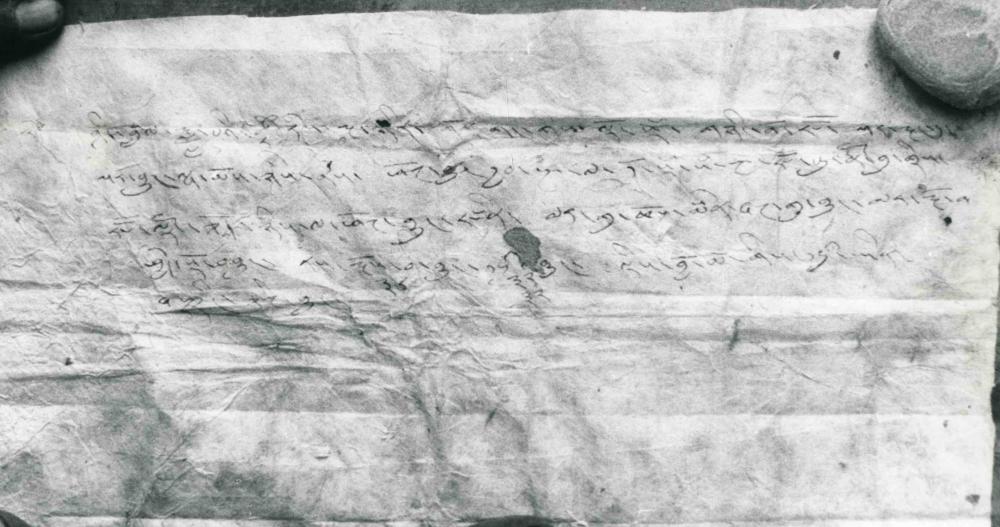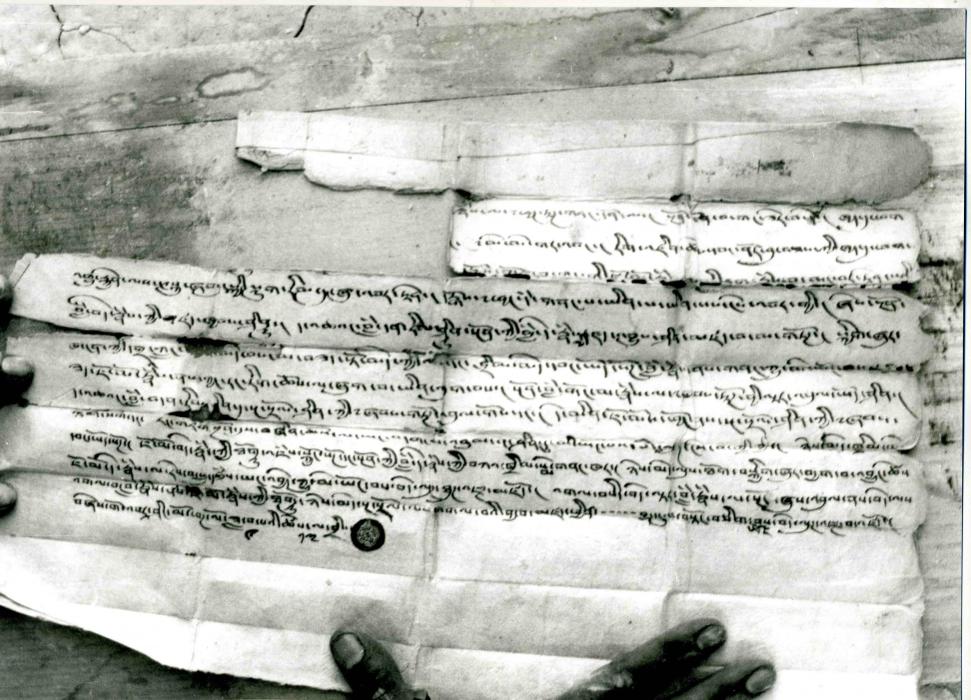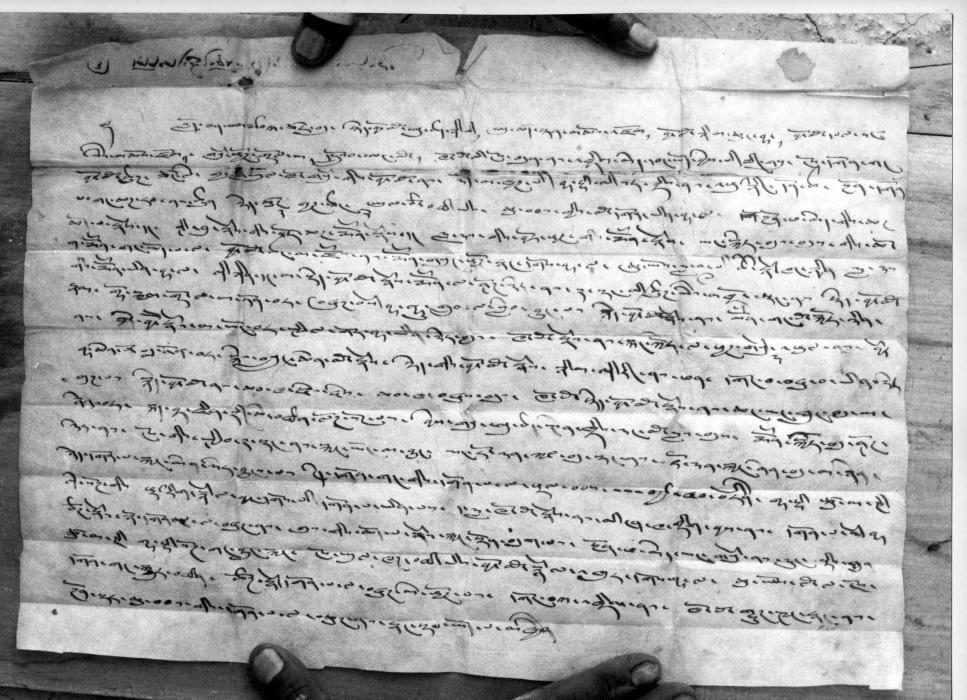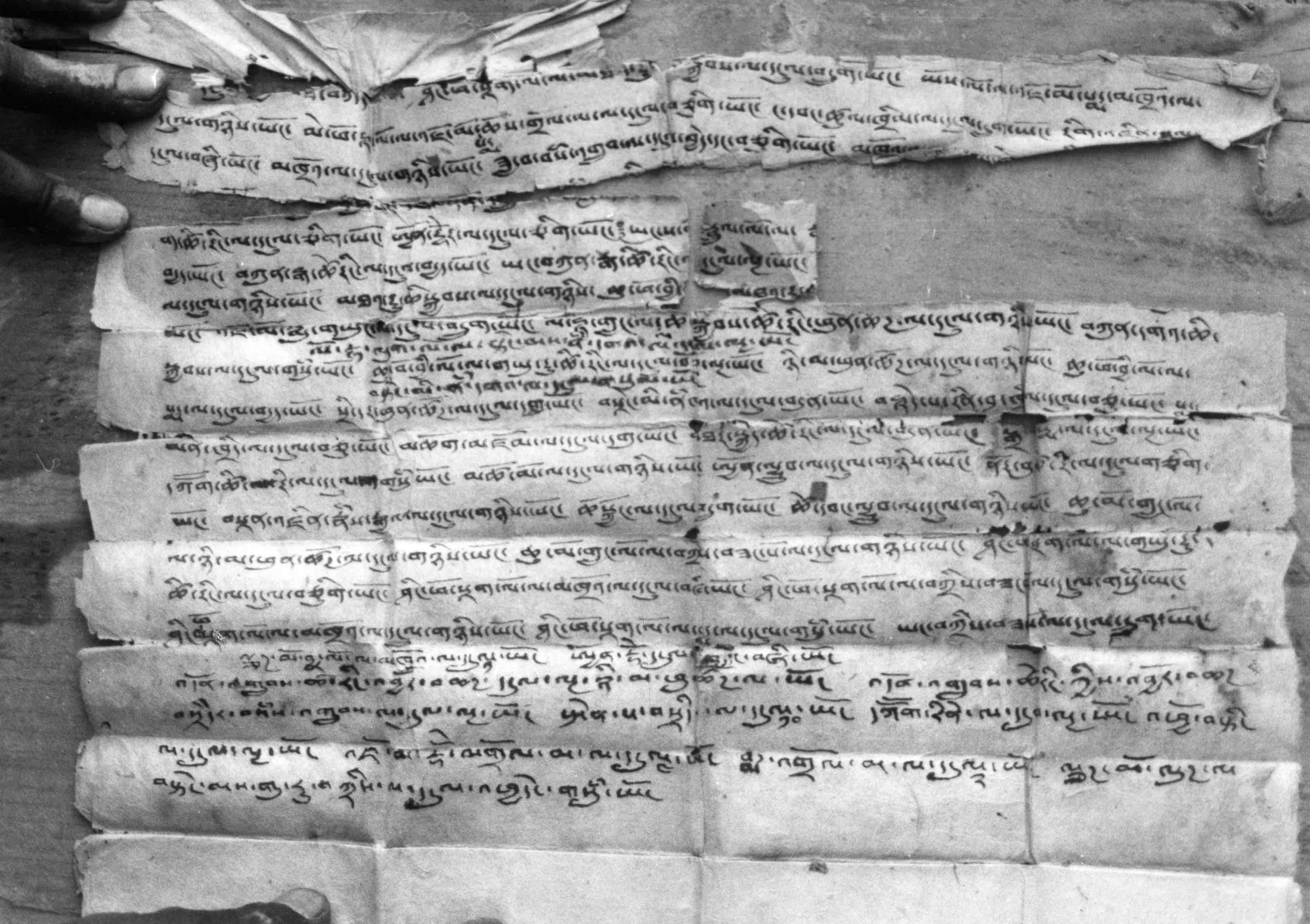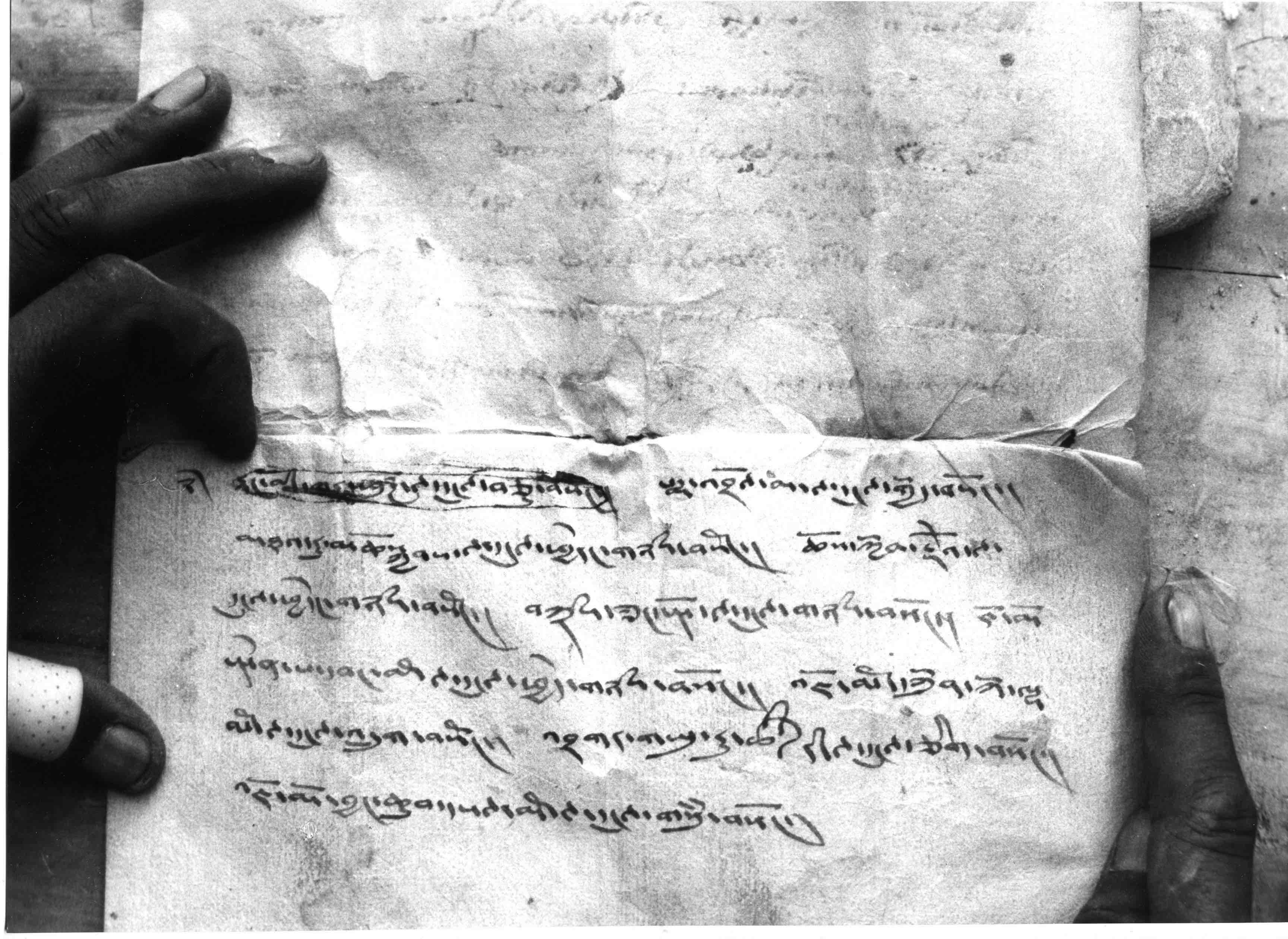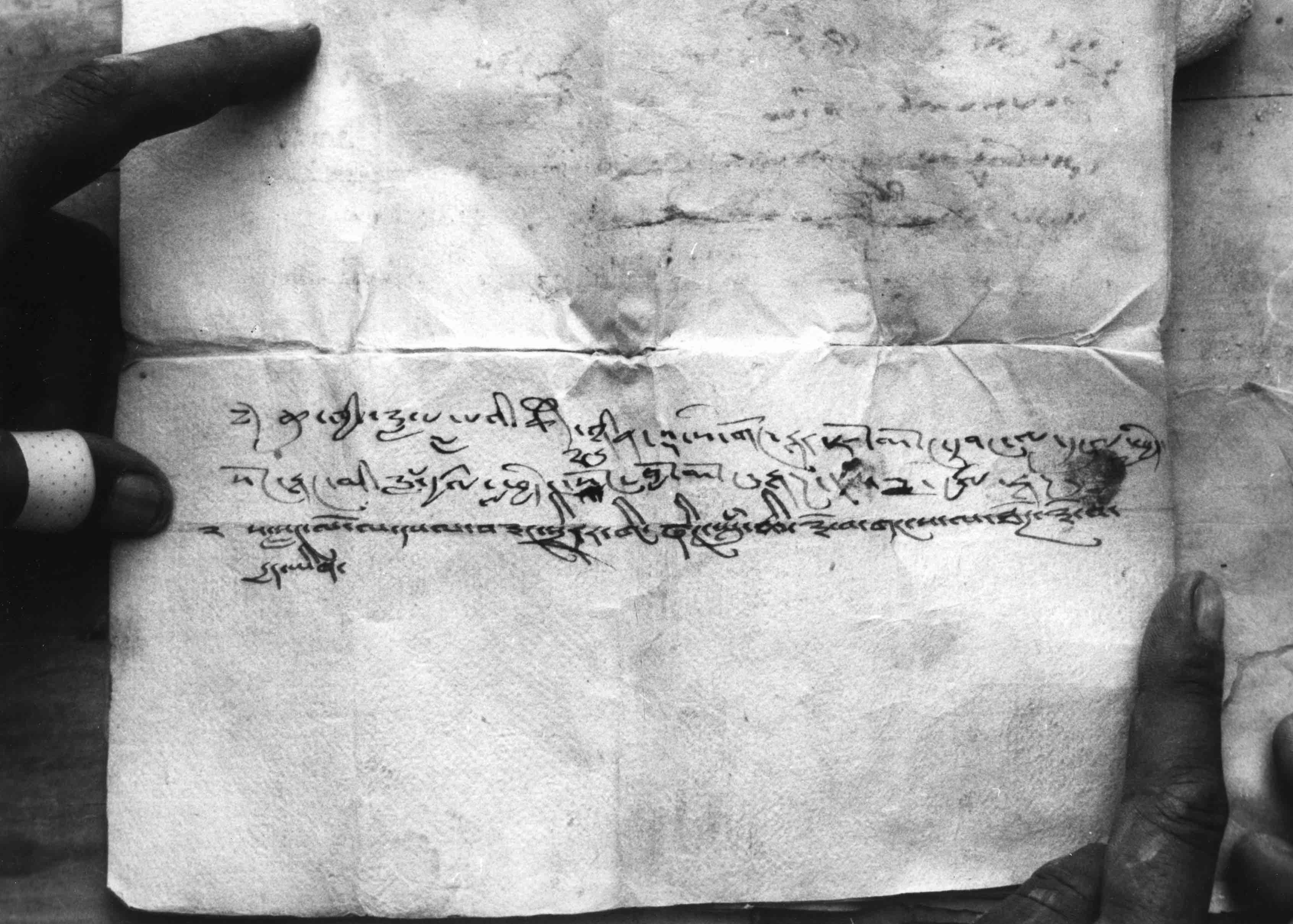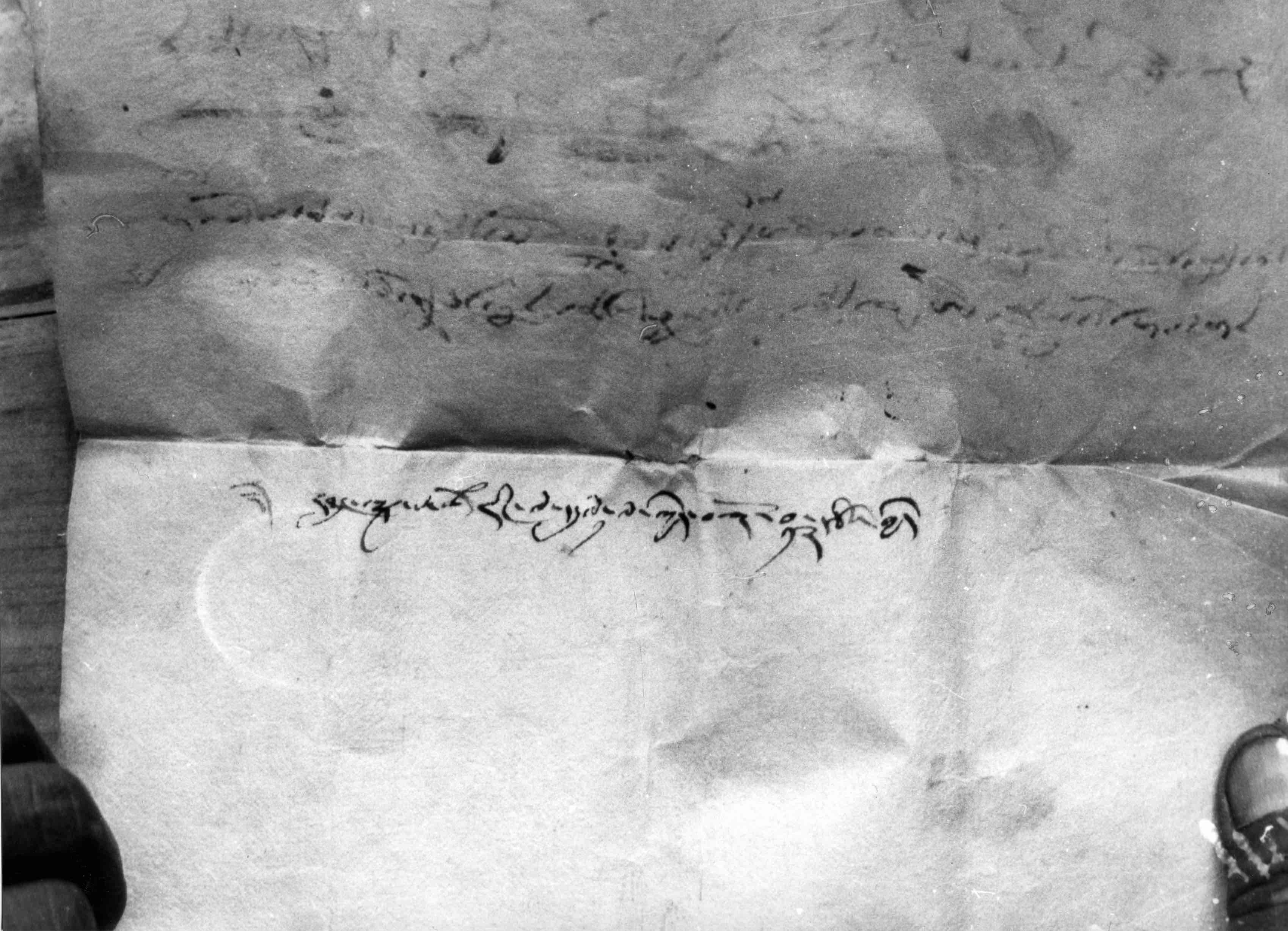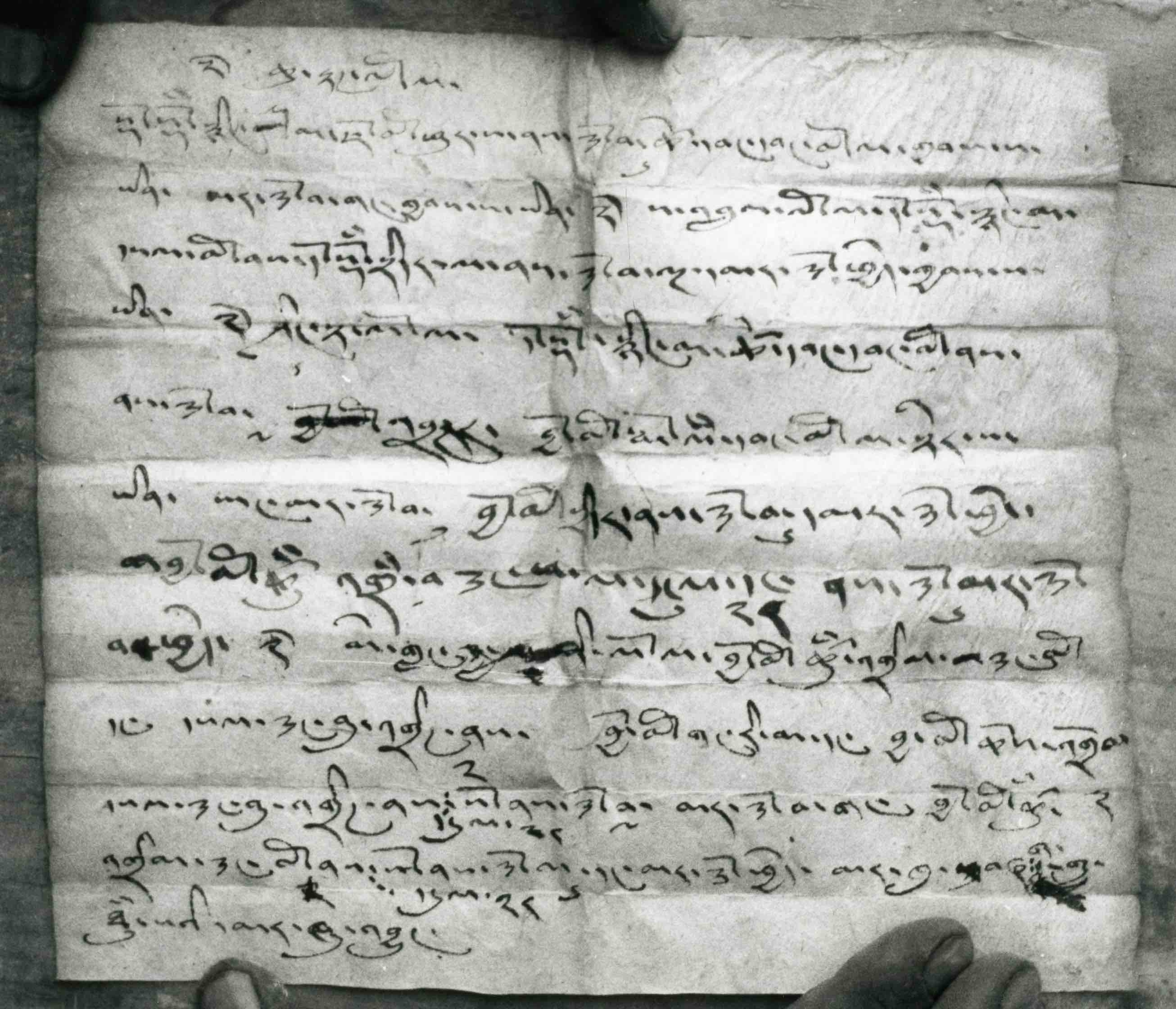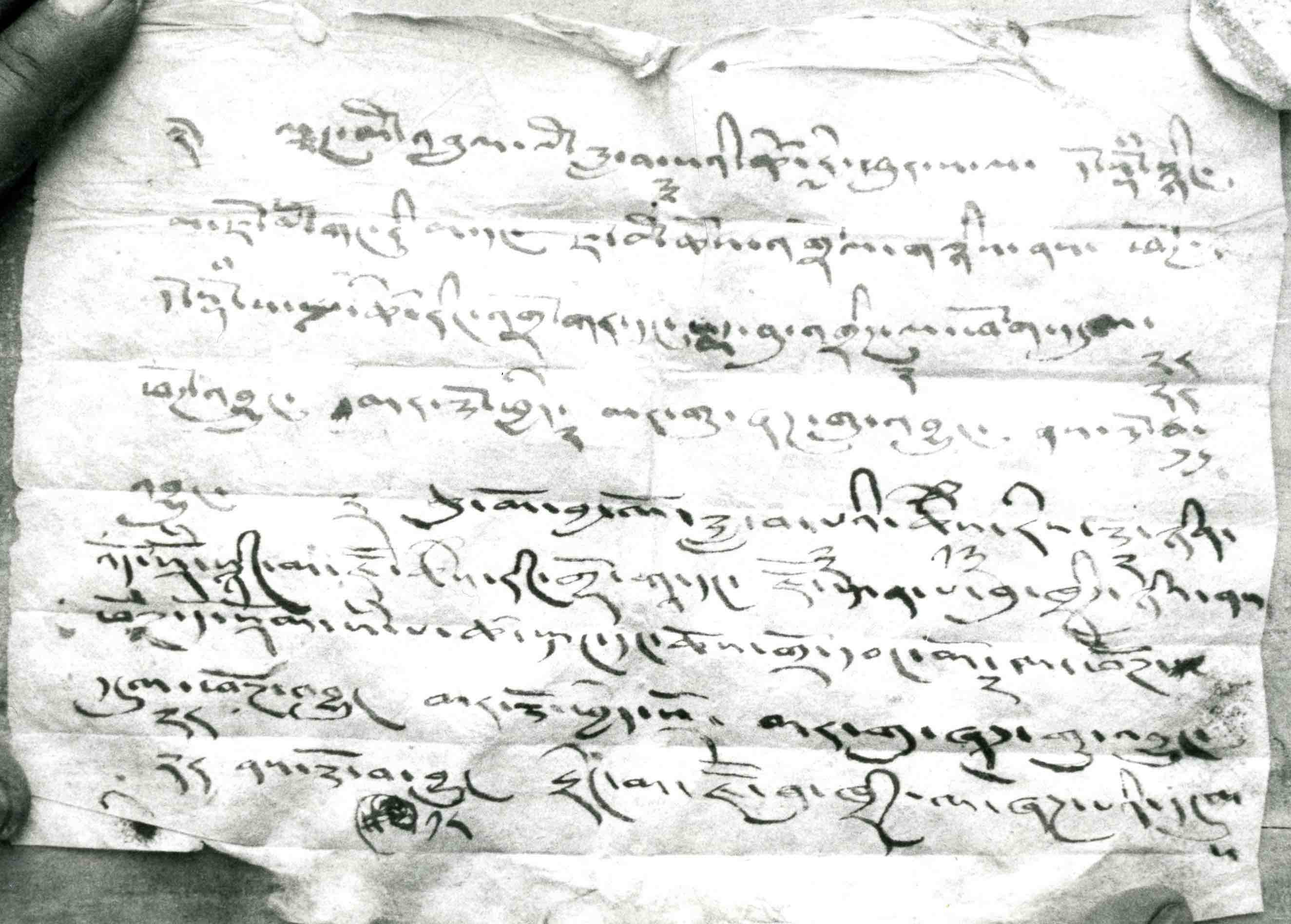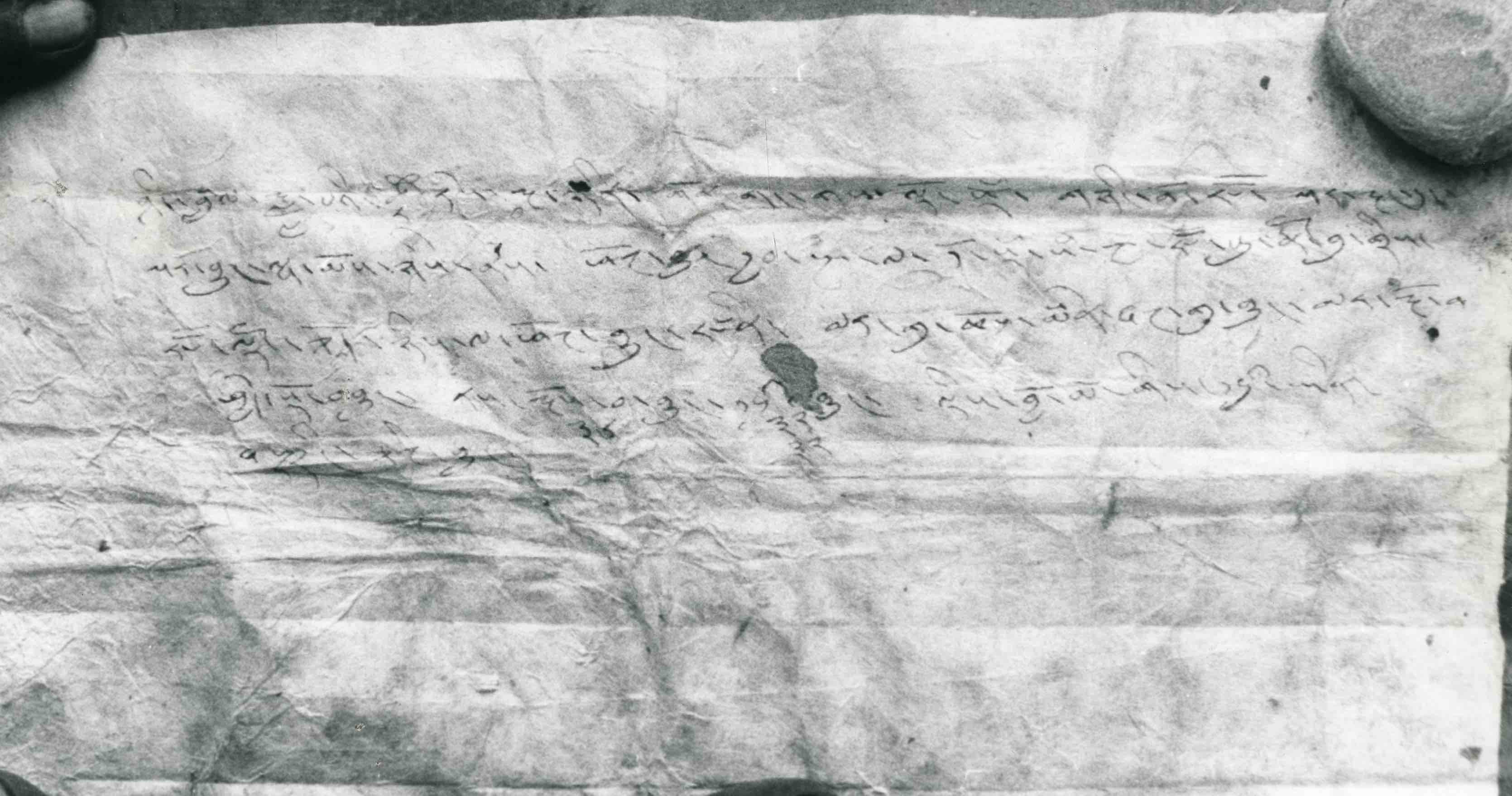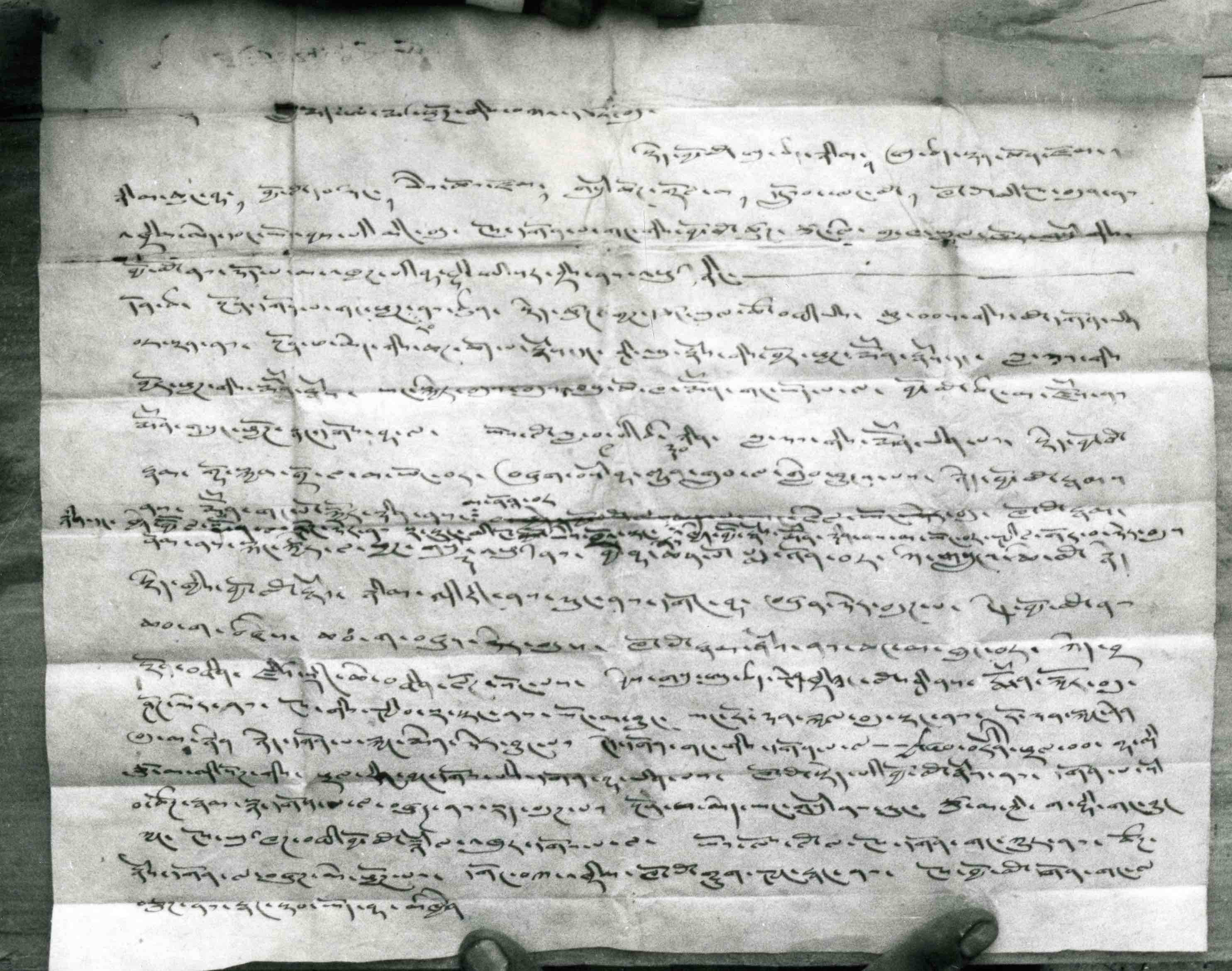Date: Water Hare (1903)
Lines: 19
Script: ’khyug
Summary
Te’s nuns turned up late to a ceremony at Künzang Chöling, prostrated in front of the Maitreya image and announced that they would no longer be members of the convent. They also rejected an invitation to drink beer with their fellows and to participate in a funeral lunch for a past dbu mdzad. They declare that they are now affiliated to Tshognam temple. This letter requests the sku zhabs to force them to return. The fiscal status of Künzang Chöling is also mentioned.
Transliteration
1. § slo smad a smal bka’ tsar bdu | rted byo mo u tshad nyi ma 1 | u tshad stan mchos ’dzom 1 | byo mo nyi ma chung bha 1 | byo mo dpal zangs |
2. yees (ye shes) mchos dzom1 | gsuṃ phyogs grol ma 1 | dngruosb (dngos grub) ang mo 1 | kho po mi ngos bdun nas ’khrim med dbang yod byes pa’i ming gsu | ngos dgon gang
3. byo mo tshugs | tsang li | gya ga yul kho gsuṃ gi byo mo nas/ zod ma khyags pa’i bha rdi i sar bris nas ’phul nying don tsha | sngon dgon
4. pa gang chags rab nas tshun | sted tshugs 2 | gyags tsang 2 | yul tsho bzhi yis | chu babs gyis mo dgon yin bha la | {1S} sngon pha med gis chags
5. chod pa rnaṃ dang | shi bu rnaṃs gis byor chags smonṃ (smon lam) rnaṃs dang | zla zas gis byor phyags gi smon laṃ rnaṃs | yang skyer bdus bdus gis cho
6. ga smonṃ (smon lam) gang yod pa la | byo mo tshang ma dzoṃs nas smon laṃ gsung phyogs rnang dgos bha la | chu yos zla 9 pa’i tshe rnaṃ khang nyin | zla zas
7. gis smonṃ (smon lam) yin bha la | ’di nyin dang ma sted byo mo rnaṃs smonṃ (smon lam) la shogs zer nas sda stang mi tshug yees (ye shes) mkhro’ (mkha’ ’gro) stang nas | sted byo mo
8. rnam | gho skyam gro la ma non bar | bzhugs bsam bha lhun grub la sleb byung pa | sted byo mo rnaṃs nas | monṃ (mon lam) gang po skyor zin
9. nas | khyod byoo (byo mo) rnaṃs ma yong bar spyi la gor bha yin zer bdus | kho po rnaṃs nas skang kyer la phyags gsuṃ 3 ’phul nas byaṃ
10. bha chen por/po pad ma ’on bar skes bsrung chen mo rnaṃs sted gis byo mo rnaṃs nyi ma ’di ring nas phan | dgong ba bzhu ba yin bzer
11. bdugs pas | snyed byo mo nas chab kha zhes zhes chab kha bzhus bdus | kho po sted byo mo rnaṃs nas chang yang thung bdu ma
12. nyen bar | skad bra dzin sding che bzhin logs song pas | byes gsu u tshad spen khris (khra shis) zang mo zlas bdus | smonṃ (smon lam) skyor bdu shogs
13. zer nas | ngos gis spyi ba sda stang nas skyang yong ma byung | yang ro zan kyal bdu stang nas ro zan skyang nen bdu ma nyen |
14. nyed dgon pa skyang men zer byungs pas | nged dgon gang gis dgon pa la phral babs --- brgyal Zzhab porien (rin po che’i) | gha rdi tsu ma ṇi
15. ’di sogs gis | phral rig rnyaṃ la byang dgos pa’i dgon pa yin pas | da zla kho po rnaṃs nas mi ngan kha grig byas nas | dgon pa saṃ bha
16. tshogs rnaṃs snya dgon spa la bzhugs nas | bdus gis chod pa rnaṃs skyang ston bdug pas | sngon pha med yang gsuṃ nas zung bhis thun
17. tsu ma ṇi | gha sdi sogs gang byung skyang | ngos yul khags bzhi yis byo mo snyaṃ la ’khur dgos bha la | chu yos lo la ngos
18. dgon gang skyur bzhin | tshogs rnaṃ dgon pa la bzhugs me phyogs pas | dgong bka’ ’khrim nas | kho po ghugs spyang rnang nas
19. sngon star chu babs gis dgon pa la | btsugs nas rnang stab yod pa mkhyeen (mkhyen mkhyen) |
Emendations
1. glo smad amāl kacahari; jo mo dbu mdzad 2. khrims med; byed pa’i ming du 3. bzod ma bkyags pa’i badi ijār; snying don rtsa 4. chags rabs; pha mes kyis phyag 5. mchod pa rnams; sbyor ’jags; dasāĩ gyi sbyor ’jags; yang bskyar dus dus kyi 6. gsung chog gnang dgos pa; nam gang nyin | dasāĩ 7. yin pa la; shog zer nas brda gtong mi; btang nas 8. rnams | mgo skyabs ’gro; bsam pa 9. ’gor ba yin zer dus; rkang kyer la phyag 10. bka’ srung chen; dgongs pa zhus pa yin zer 11. ’dug pas; nyed jo; chabka (SMT honorific for chang) bzhes; chabka zhu dus 12. nyan par; skad sgra dzeting; log song; rjes su dbu mdzad; ’das dus; skyor du shog 13. brda’ btang nas kyang; skyel du btang; kyang nen du ma nyan 14. man zer byung; khral ’bab; rgyal zhabs; gaddi cumāni 15. khral rigs mnyam la sbyong; da lta kho; khag dkri byas; dgon pa sampa (SMT < gsar pa) 16. nya (SMT < ya) dgon pa la zhugs nas; dus kyi mchod pa rnams kyang ston ’dug; nas bzung; bhis thun (? see commentary) 17. cumāni | gaddi sogs; byung yang; mnyam la ’khur dgos pa 18. zhugs mi chog pas; gong bka’ khrims; ’gugs ’chang gnang nas 19. sngon ltar; btsugs nas gnang stabs
Translation
To the court of Lower Lo.
These seven nuns of Te: the [former] precentor, Nyima; the [former] precentor Ten Chöndzom; Nyima the Younger; Sister Palzang; Yeshe Chödzom; Sumchog Drölma; Ngödrub Angmo – these individuals who have acted lawlessly and brazenly. We nuns from the three communities of Tshug, Tsele and Gyaga, no longer being able to endure this, we submit this petition (bādi ijhār).
Ever since its foundation, Gönpa Gang has continually been the nunnery of the four communities of Te, Tshug, Gyaga and Tsele: the offerings and ceremonies performed by our forebears; the prayer meetings that have been endowed on behalf of the deceased; for the prayer meeting enabled by the endowments for the Dasain ceremony; and, further, all the periodical rituals and prayers; all the nuns would have to assemble and perform these prayers and rituals.
The 30th day of the 9th month in the Hare year, was the day of the prayers for the Dasain festival. On this day, we first of all sent Yeshe Khandro of Tshug to invite the nuns of Te to come for the prayers. The nuns of Te had not arrived by the Taking of Refuge that begins the ceremony, but came only much later, at the Prayer that Spontaneously Fulfils Wishes (bSam pa lhun grub, with which the ceremony closes): they came only after we had finished reciting all the prayers. We asked them how it was that they had come so late; but they made a triple gesture of reverence without prostrating themselves, and said, “Great Maitreya, Padma ’Od ’bar, protectors of the doctrine! From this day on, we beg to take our leave!” We nuns invited them to sit down with us and to have some beer, but they refused to have any, and went back amid much shouting and yelling.
On a later occasion, when the preceptor Sister Pen Trashi died, we sent our steward to call them to take part in the prayers, they did not come; and when we sent them the “corpse food” [the food that is distributed after the death of an individual], they refused to accept it, saying that they were no longer members of the convent. But Gönpa Gang is the convent for which we have shared fiscal obligations, for which we have to pay the gadi cumāni and other taxes to the government. Now these seven nuns have made an illicit agreement with a new religious establishment, Upper Tshognam. (Line 16) We have to perform the periodical ceremonies, and moreover, we nuns of the four communities have been collectively responsible for whatever [dues] there may be, such as bhis thun, tsu ma ṇi and gha sdi. In the Hare year they abandoned Gönpa Gang, but they should not be allowed to join Tshognam temple, and we therefore humbly request you to apprehend them and to reinstall them in the convent to which they have traditionally belonged.
Note
Lines 16–17, bhis thun tsu ma ṇi | gha sdi sogs gang byung skyang | ngos yul khags bzhi yis byo mo snyaṃ la ’khur dgos... : “we nuns of the four communities have been collectively responsible for whatever [dues] there may be, such as bhis thun, tsu ma ṇi and gha sdi.” The Nepali term to which bhis thun corresponds is not clear, but may be connected to beṭh, “Rent for land paid in kind” (Turner 1931); tsu ma ṇi/rtsu rman, which appears in KCh/01 as a category of tax—assessed as 10 rupees per year—that Künzang Chöling had to pay in 1904, probably stands for the word cumān(i), “kissing”, and gha sti/gha sdi for gaddi, “throne”. Until further information is available, we may conclude tentatively that these are all categories of taxes or other payments on religious estates that were considered at least partly to be symbolic gestures of loyalty or subservience to the Nepalese Crown.
Commentary
The following document, KCh/38, appears to be an earlier draft of the present one. The handwriting is less careful and there are more deletions, and it is also worth noting that this document, KCh/37, presents the nuns of Künzang Chöling in a less confrontational light: it omits a passage, contained in KCh/38, to the effect that the nuns angrily questioned their sisters from Te on the reason for their lateness, and threatened them with a fine. The omission is probably intended to present the authors as the more reasonable party in the dispute; the Tepa nuns, by contrast, showed scant reverence to the divinities in the temple insofar as they did not prostrate fully, and left amid much shouting. Interestingly, the document that presents the Tepa nuns’ side of the story claims that they were “dragged outside by all the other nuns of Tshug convent, who expelled them with the notification that they should not come back” (Tibetan Sources 2, HMA/UTshognam/Tib/23).
